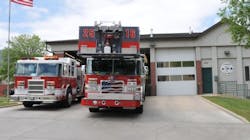CO Fire Department to Focus on Hiring More Female FFs
When Carol Brown became a firefighter for Boulder in 1991, there were about twice the number of women in the city’s department than there are today, she said.
Now a battalion chief for Boulder Fire-Rescue, Brown is excited to see its leaders make it a goal to increase the number of women firefighters from the current 7% to 25% of its sworn firefighters by 2030, which total 112 now, according to Deputy Fire Chief Holger Durre.
That goal, among many others, including the potential transition away from the fire department relying on a contractor to perform advanced life support ambulance service, was unanimously adopted Tuesday by City Council in an updated master plan for Boulder-Fire Rescue.
Pinpointing exactly what has limited the city’s recruitment of women firefighters in the past decade is difficult, Durre said, but Brown believes a change in hiring practices that has led to cities in the region selecting from a single pool of firefighting applicants has had an impact, with women encouraged to apply by Boulder firefighters sometimes hired by other cities in the area when they would have applied to work specifically in the city in years past.
The updated master plan recommends redesigning the city fire service’s recruiting program to “target non-traditional candidates, especially female applicants.”
Plus, Brown contends, news coverage after the Sept. 11, 2001, tragedy focused heavily on the hundreds of men in the Fire Department of New York who perished while rescuing people, which she believes slowed a movement away from many people using the gendered term firemen, rather than firefighter, thus discouraging women from pursuing the fire service.
“I think women just excel” in the fire service, Brown said. “Truly, I think that the fire service has changed from, we fight a fire every day, to now the majority of our calls, 80% to 85% are for emergency medical service. … Everybody doesn’t have to look like an NFL linebacker, and if they do, your crew is going to suffer because you need to have diversity in thought, gender and size.”
While Boulder Planning Board questioned why the department’s focus on gender, and not racial diversity, was reflected in the master plan, fire service leaders said its staff already represents the community well in terms of its varied staff demographics.
“Our real goal is to bring a more broad conversation from various perspectives. The place we can make the biggest impact on that is on our gender demographic,” Durre said, adding the department also employed more women as firefighters 10 and 15 years ago than it does now.
Molly Cropp last year became one of the women firefighters in Boulder after leaving the Longmont fire service; she finds the Boulder atmosphere “very inclusive,” and not at all like a “boys club.”
“I love being a firefighter in Boulder. I’ve found that if you can prove you can do the job, no one questions whether you’re male or female,” Cropp said. “… I think recruiting more females into the fire service starts with women seeing other women doing the job. … I think Boulder has a lot of potential, though, with having University of Colorado here.”
The master plan also delves into the department’s potential funding scenarios over the next decade, with the 2020 budget of $22.99 million as a reference point. The fire department has suggested it would need an $8.48 million investment to complete construction of Fire Station No. 3, but would need $59.61 million more to achieve its “action level” of service improvement.
That would involve relocating and building both Fire Station No. 2 and Fire Station No. 4, at Baseline and Broadway and 4100 Darley Ave., respectively, which Fire Chief Mike Calderazzo in December said currently do not have gendered bathrooms, meaning men and women have to share. Upgrading those stations is critical, Calderazzo said, as the city continues to grow, especially with the potential development of the CU South property in south Boulder.
The action level of funding could also move the needle toward Boulder Fire-Rescue achieving its ambulance service goals to bring advanced life support services in house, meaning the city would no longer have to contract American Medical Response for providing the administration of life-saving drugs, performance of invasive procedures and the full scope of cardiac resuscitation in the field.
Boulder Fire-Rescue in December said an “action level” of funding — meaning a step up from maintaining its current level of service for which $22.99 million is budgeted in 2020, accounting for 13% of the General Fund budget — would require $1.78 million more in annual costs and $1.14 million in capital investments to achieve advanced life support goals.
That would allow it to staff two light-response medical vehicles and transition 32 existing staff from basic emergency medical technicians to the higher paramedic level.
“I do think we can have a discussion when we get to budgeting whether we want to do action or (the more expensive) vision-level funding,” Mayor Sam Weaver said. “Ultimately, I think we want to end up at the vision plan, I think we want to do our own (emergency medical) transport.”
———
©2020 the Daily Camera (Boulder, Colo.)
Visit the Daily Camera (Boulder, Colo.) at www.dailycamera.com
Distributed by Tribune Content Agency, LLC.
